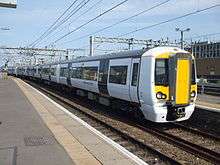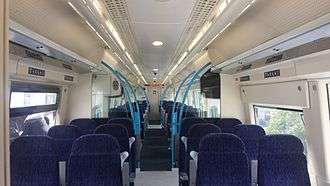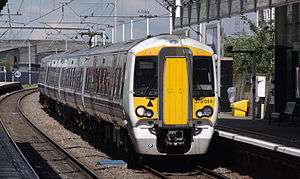Electrostar
| Electrostar | |
|---|---|
|
Class 377, no. 377 213, at Harrow & Wealdstone station on 28 September 2004. This unit is in the Southern livery. | |
| In service | 1999 - present |
| Manufacturer |
Bombardier Transportation, Derby (formerly ADtranz) |
| Replaced |
Class 421 Class 423 Class 319 Class 456 Class 313 Class 508 Class 365 Class 466 Class 411 Class 465 Class 310 Class 317 Class 312 Class 442 Class 165 Class 166 Class 321 |
| Number built | 480 trainsets |
| Formation | 3, 4 or 5 cars per trainset |
| Capacity | Varies depending on number of carriages and seating configuration, see individual articles for details |
| Operator(s) |
Abellio Greater Anglia c2c Southeastern Southern London Overground Thameslink Gautrain |
| Specifications | |
| Car length |
Class 357: DMSO: 20.75 m (68 ft 1 in) each, MSO and PTOSL: 20.10 m (65 ft 11 in) each Classes 376 and 377 DMSO: 20.4 m (66 ft 11 in) each, MSO and PTOSL: 19.99 m (65 ft 7 in) each |
| Width | 2.80 m (9 ft 2 in) |
| Height | 3.78 m (12 ft 5 in) |
| Maximum speed |
75 mph (120 km/h) (376/378) 100 mph (160 km/h) (357/375/377/379) 110 mph (180 km/h) (387) |
| Weight |
Class 357: 157.6 t Classes 375/3 and 377/3: 133.1 t Classes 375/6, 375/7, 377/1, 377/2: 173.6 t |
| Power output |
2x373 = 746 kW kW (377/3 only) 3x373 = 1,119 kW (others, third rail) 3x560 = 1,680 kW (AC mode) |
| Electric system(s) |
25 kV AC Overhead lines 750 V DC third rail |
| Safety system(s) | AWS, TPWS |
| Track gauge | 1,435 mm (4 ft 8 1⁄2 in) |
Electrostar is the name given to a series of related electric multiple-unit (EMU) passenger trains manufactured by Bombardier Transportation (formerly ADtranz) at their Litchurch Lane Works in Derby, England. Since the privatisation of British Rail, it has become the most common new EMU type in Britain, where different variants referred to as Class 357, Class 375, Class 376, Class 377, Class 378, Class 379 and Class 387, are most common on the high-volume suburban commuter routes in South, North and East London, and mainline services south to Surrey, Sussex, Kent & South Essex coasts and north to Cambridge and Stansted Airport . It shares the same bodyshell and core structure as the Turbostar, which is in turn the most common post-privatisation diesel multiple unit (DMU) family, and both evolved from the Class 168 Clubman design by ADtranz.
The Clubman/Turbostar/Electrostar platform is a modular design, which share the same basic design, bodyshell and core structure, and is optimised for speedy manufacture and easy maintenance. It consists of an underframe, which is created by seam-welding a number of aluminium alloy extrusions, upon which bodyside panels are mounted followed by a single piece roof, again made from extruded sections. The car ends (cabs) are made from glass-reinforced plastic and steel, and are huck-bolted onto the main car bodies. Underframe components are collected in ‘rafts’, which are bolted into slots on the underframe extrusion. The mostly aluminium alloy body gives light weight to help acceleration and energy efficiency.
The Electrostar was also selected for use on the Gautrain system in South Africa, a new railway between Johannesburg, Pretoria, and the Johannesburg International Airport. The trains were assembled by UCW Partnership in South Africa from components made in Derby.[1]
Transport for London (TfL) announced in August 2006 that it had ordered 48 three- and four-car Electrostar trains for the new London Overground service. These were categorised by Network Rail as Class 378, and entered service in 2009 to replace the Class 313 and Class 508 on the North London Line and West London Line, and to provide the opening service on the new East London line extension from 2010.[2]
In 2009, as part of the government's wider rolling stock plan, an order was placed for thirty four-car Class 379 Electrostar units intended for use by National Express East Anglia (now operated by Abellio Greater Anglia) on the Stansted Express and West Anglia services.[3] The first of the new Class 379 units entered passenger service on Thursday 3 March 2011 running the 20:10 Stansted Express from London Liverpool Street to Stansted Airport and the 21:15 return service.
Electrostar variants
| Class | Image | Operator | Introduced | Number | Power | Carriages | Door configuration | End gangways | Notes |
|---|---|---|---|---|---|---|---|---|---|
| 357 Electrostar | | c2c | 1999 | 74 | AC electric | 4 | "Plug" style | No | Class 357 c2c trains have now got a white National Express livery. |
| 375 Electrostar | | Southeastern | 1999 | 112 | Dual Voltage/DC electric | 3 or 4 | "Plug" style | Yes | Classes 375 and 377 differ only in their coupler configuration and other minor fittings; all Southern units built as Class 375 have since been converted to Class 377 couplers and re-classed. Minor differences in interior trim remain.Class 375/6 is dual voltage |
| 376 Electrostar |  | Southeastern | 2004 | 36 | DC electric | 5 | Sliding pocket | No | |
| 377 Electrostar |  | Southern, Thameslink | 2002 | 239 | Dual Voltage/DC electric | 3, 4 or 5 | "Plug" style | Yes | 377/6 and 377/7s have been built with different exteriors, matching the 379s and 387s. |
| 378 Capitalstar |  | London Overground | 2009 | 57 | Dual Voltage/DC electric | 4 or 5 | Sliding pocket | Emergency use only | The Class 378s were constructed in three separate batches - 24 three car units designated as Class 378/0 with dual voltage capability were utilised on the North London Line and West London Line. 20 four car DC-only units designated Class 378/1 were built for the East London Line. 13 four car Class 378/2s were also built, and the 378/0s had an extra car added to make them 378/2s. All currently (2014) being extended to 5 cars. |
| Gautrain Electrostar | | Gautrain | 2010 | 24 | AC electric | 4 | "Plug" style | No | Two four-car sets can be coupled together to operate in multiple as an eight-car set. |
| 379 Electrostar |  | Abellio Greater Anglia | 2011 | 30 | AC electric | 4 | "Plug" style | Yes | The Class 379s incorporate some technical features of the proposed Aventra Mark II Electrostar.[4] However they are outwardly similar to classes 375 and 377. |
| 387 Electrostar |  | Thameslink, Gatwick Express , Great Western Railway | 2014 | 64 | Dual Voltage | 4 | "Plug" style | Yes | Units under construction until 2017. Class 387s for Thameslink have been ordered to cope with extra service before enough Class 700s are built. These will then transfer to Great Nothern. 387/2s will replace Class 442s on Gatwick Express and all GWR diesel units on Thames Valley services. |
Electrostar routes
c2c
c2c uses Class 357 units on services down the London, Tilbury and Southend Railway line from Shoeburyness and Southend to London Fenchurch Street.
Southeastern


The Class 375 is the backbone of Southeastern's long distance routes, seeing services on most of its lines originating from its London termini (London Victoria, Charing Cross, Cannon Street and London Bridge) including;
On the outer suburban portions of these above routes, Class 465/9 Networkers support the Electrostars, but they do not work in multiple together.
The Class 376 operates on the metro routes in suburban London, in conjunction with the Class 465 and Class 466 Networkers, operating over the London portion of the above lines from the London Termini (including Blackfriars) out to Dartford and Sevenoaks);
- North Kent Line (to Dartford)
- Bexleyheath Line (to Dartford)
- Dartford Loop Line (to Dartford)
- Chatham Main Line (to Sevenoaks)
- Maidstone East Line (to Sevenoaks)
- South Eastern Main Line (to Sevenoaks)
- Hayes Line
This leaves the Bromley North Line and Sheerness Line, both operated by Class 466s (2 car Networkers) which also used to operate on the Medway Valley Line prior to the May 2012 Timetable Changes.
Southern

Southern's Class 377 fleet is found on all parts of the network apart from the non-electrified routes. They also now run frequently in metro routes alongside the Class 455s and used to run alongside the Class 456s until their transfer to South West Trains in 2014.
Main lines
- Brighton Main Line (Victoria–Gatwick-Brighton)
- East Coastway (Brighton–Eastbourne/Hastings)
- West Coastway (Brighton–Portsmouth/Southampton)
- Arun Valley Line (Victoria–Horsham/Littlehampton/Chichester)
- West London Line (South Croydon–Milton Keynes Central) (Using Dual Voltage Class 377/7)
Outer suburban
- London Victoria–Horsham via Dorking
- London Victoria–East Grinstead
- London Bridge–Horsham via East Croydon
- London Victoria-Reigate
- London Victoria-Tonbridge via Redhill
Suburban
Often found on
- London Victoria–Dorking via Sutton
- London Victoria–Epsom Downs
- London Bridge-London Victoria via Sydenham
- London Bridge-Caterham
- London Victoria-Caterham
- London Victoria-Epsom
- London Bridge-Tattenham Corner
377s can be also found running overnight on Southern London Victoria–Brighton duties at 1:00am and 4:00am, calling at Clapham Junction, East Croydon, Horley, Gatwick Airport, Three Bridges.
London Overground
London Overground operates Class 378s over five lines around London:
- North London Line (Richmond–Stratford)
- West London Line (Clapham Junction–Stratford)
- Watford DC Line (Euston–Watford)
- East London Line (Clapham Junction/Crystal Palace/New Cross/West Croydon–Highbury & Islington via Canada Water)
The sixth major route it's responsible for is the unelectrified Gospel Oak to Barking Line. For this, London Overground obtained Class 172 Turbostar DMUs.
Thameslink
From March 2009 First Capital Connect (now Thameslink) ran 23 x 4 car Class 377's on the Thameslink Bedford to Brighton route, this increased to 26 x 4 car Class 377's in late 2011. This arrangement has continued since the franchise transferred to Govia Thameslink Railway in September 2014.
- Thameslink, Bedford to Brighton
- Thameslink, Bedford to Ashford International/Gillingham/Bearsted/Rochester peak only services. (These services are jointly run by Govia Thameslink Railway and Southeastern with services north of Blackfriars operated by Thameslink and south by Southeastern - until December 2014 when Thameslink took over the whole route)
Gautrain (South Africa)
On 8 June 2010, the route between Sandton and OR Tambo International Airport in South Africa opened in time for the 2010 FIFA World Cup.[5] The rest between Johannesburg Park Station and Rosebank was to be completed in 2011. This section was actually opened 7 June 2012,[6] the delay caused by work to resolve a water-seepage problem in the single-track tunnel section between Rosebank and Park. Although railways in South Africa use the 1,067 mm (3 ft 6 in) Cape gauge, Gautrain is built to the more expensive standard gauge of 1,435 mm (4 ft 8 1⁄2 in). According to the Gautrain planning and implementation study,[7] this is done for several reasons, including that standard gauge is safer and more comfortable to passengers. The rolling stock is also easier, quicker and less expensive to obtain than Cape Gauge rolling stock, and standard gauge is also less expensive to maintain as it is more tolerant of track imperfections than Cape Gauge. Standard gauge allows for travel at Gautrain's required speed of 160 km/h (99 mph).
Abellio Greater Anglia

From March 2011 National Express East Anglia introduced 30 x 4 car Class 379s on Stansted Express and West Anglia Main Line services.[8] These incorporate some features of Bombardier's planned 'Aventra' Mark 2 Electrostars.[4]
All units had entered service by mid-August 2011, two months ahead of schedule. A major timetable update in December 2011 entailed the introduction of 12-car trains on some peak workings to and from Cambridge.[9]
These trains are now operated by Abellio Greater Anglia as of 5 February 2012.
Diagrams
Class 357, c2c
Class 375, Southeastern
Class 376, Southeastern
Class 377, Southern, Thameslink
Class 378, London Overground
Class 379, Abellio Greater Anglia
![]()
Gautrain
See also
- Bombardier
- Thameslink and Great Northern
- Southern
- Southeastern
- London Overground
- c2c
- Abellio Greater Anglia
- Gautrain
- Turbostar
References
- ↑ "Bombardier Selected Preferred Bidder for Rapid Rail System in South Africa". Bombardier. 2 July 2005. Archived from the original on 22 July 2011. Retrieved 15 October 2012.
Bombardier Transportation’s facility in Derby, United Kingdom, will be responsible for manufacturing the fleet of Electrostar vehicles, with final assembly performed in South Africa by UCW Partnership, a broad-based empowered subsidiary of Murray & Roberts.
- ↑ "TfL awards £223m new trains contract". Transport For London. 31 August 2006. Archived from the original on 11 March 2007. Retrieved 15 October 2012.
Funded by TfL's £10 billion Investment Programme, the new trains will operate on the North London Railway, which TfL will manage from November next year, and the extended East London Line.
- ↑ "Express delivery". Railfuture. 4 April 2009. Retrieved 19 July 2010.
- 1 2 "First new Stansted Express train rolls out". Railway Gazette International. 14 October 2010.
- ↑ Smith, David (8 June 2010). "Welcome aboard the Gautrain, Africa's first high-speed urban train". The Guardian. Retrieved 12 June 2010.
- ↑ "Gautrain Rapid Rail Link: Park Station Opening". Official Gautrain Website. Retrieved 15 November 2014.
- ↑ "Gautrain Rapid Rail Link: Planning and Implementation Study" (PDF). Official Gautrain Website. Retrieved 12 June 2010.
- ↑ "National Express launches Class 379s on Stansted Express Service" (PDF). Railway Herald. 21 March 2011. p. 3. Archived from the original (PDF) on 15 October 2012. Retrieved 15 October 2012.
- ↑ "New timetable for the West Anglia network". National Express East Anglia. Retrieved 11 November 2011.
External links
- Southern Electric Group Historical Features Index
- Bombardier website - the manufacturer of the Electrostars
The Operators of the Electrostars
- c2c website (Class 357)
- Southern website (Class 377)
- Southeastern website (Classes 375/376)
- First Capital Connect website (Class 377)
- Transport for London website for London Overground (Class 378)
- Greater Anglia (Class 379)
- Gautrain website